Peter and Mary Saispair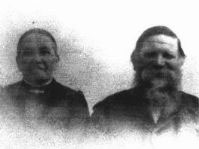
(born Per Persson and Mary Mora)
Beginning with the account of C.F. Sandahl concerning the Elim congregation, and confirmed by O.M. Nelson, we had read the name of Peter Saispair. But it was little more than a name, identified as the earliest leader of the immigrants into this part of Nebraska, and as one being of the Swedish Baptist persuasion. There was much more to the story, as we were to learn several years later.
The occasion was the publication of a book by one of Saispair's descendants, Joann Petras, called "Family of Miracles." Our friend and fellow "Swedish church finder" Jerry Rennerfeldt of Oakland sent us the announcement of a book signing by the author at the Elim church at rural Uehling. This was an opportunity not to be missed.
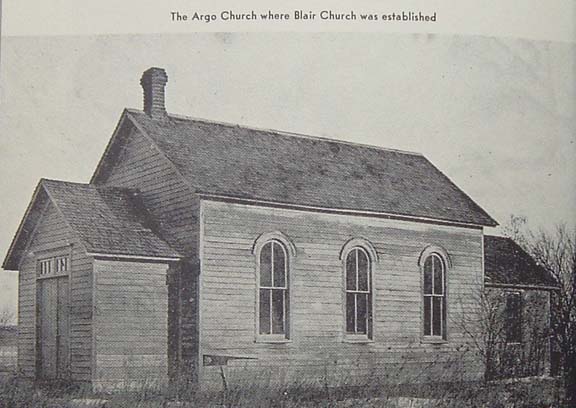
Our first glimpse of St. Johns Argo (Danish)
Earlier, Jerry had guided us through the priceless collection of the Swedish Heritage Center, once the First Covenant Church of Oakland, and we even ventured out on a field trip visiting the sites in the area. Later we encountered a picture of the St. Johns Danish Lutheran church which once stood in the area, but we were not sure just where. The event at Elim provided the answer to that question as well. (this church came later than Saispair's, when the Danes formed their own congregation)

Saispair descendants at his monument
Joann Petras is to the immediate right of the stone
One attendant question, of minor significance, was to hear just how the name "Saispair" was pronounced by the family...and what was the origin of this name which did not have a particularly Swedish sound. The answer, phonetically, was "sasper." Joann explained to another questioner that she understood that the prefix "sas" derived from "saucey," in the sense of a headstrong or assertive child, which had characterized Per (a Swedish form of Peter) from his youth. Hence, "Sas - Per," evolving into "Saispair." The answer satisfied the considerable number of his descendants gathered at the Elim book signing.
Both Jerry and I were eager to devour this book and add to our knowledge of the immigrant churches of the Swaburg / Argo communities. But in the conversations around the table in the Elim fellowship hall, even more doors were opened. There we met the Egbers, who were particularly interested in Swaburg / Argo and were able to answer our questions of where the Saispair homestead was located and much more. When asked about the original building in which the Saispair Baptist group met, they revealed something new to us. They recalled that in this one building, probably the one Sandahl refers to as "the Saispair schoolhouse," a Lutheran congregation met on Sunday mornings, a Baptist group on Sunday afternoons, and a Mission Friend group on Sunday evenings!
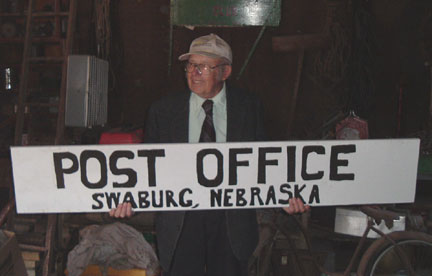
Albert Egbers, preserver of Swaburg
This striking fact was impressive enough, but did not prepare us for the answer the Egbers gave to our question concerning its location. "We have it at our place!", or words to that effect. And to top it off, they were willing to show it to us that very afternoon. Now Jerry and I were giving each other a look that silently exclaimed "we have just hit the jackpot!"
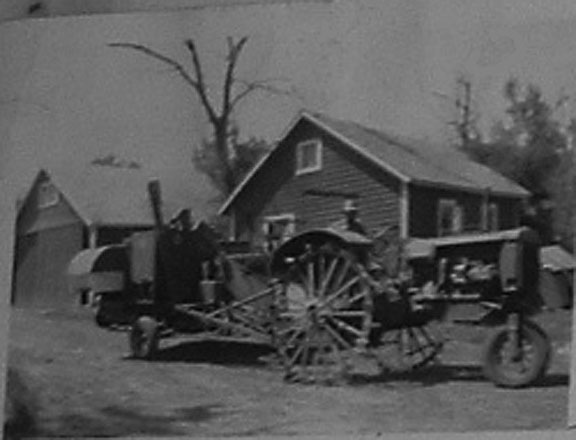
Saispair church as it appeared in 1938
Minutes later we were standing on the very old and worn floor boards of that very building. Behind the deposits of years of blacksmithing, the purpose the building had served when Egber's grandfather had moved it to his farmplace, the ornate nineteenth century wallpaper could be seen. Even an ornate, flocked window shade remained in place. The thought of standing in that place sends a shiver down one's spine, even now. Another incredible survival! Saispair's hands had built it, his preaching had echoed from its walls. Not only his, but perhaps the venerable Lutheran missionary S.G. Larson's, the missionfriend O.M. Nyman's, and others.
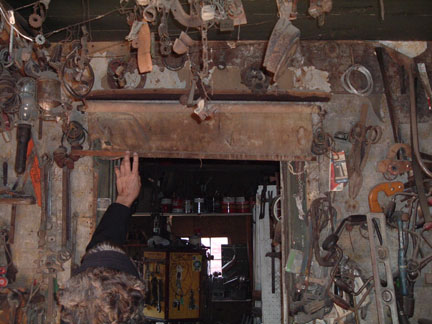
Beverly Egbers point out the original window shade
(the tools are from the blacksmith era)
The Egbers deserve our gratitude and admiration for this preservation, but their achievements warrant a story of their own, which we cannot accomplish here. Suffice it to say that they also preserve the Swaburg post office building and school on their property, a property which also includes an astonishing metal machining facility and collection of early agricultural artifacts. Giant Aultman-Taylor, Case, Rumley and Minneapolis steam engines are just the beginning of what we saw. They had provided much of the background to Joann Petras for the writing of her book. We were indeed fortunate to make their acquaintance.
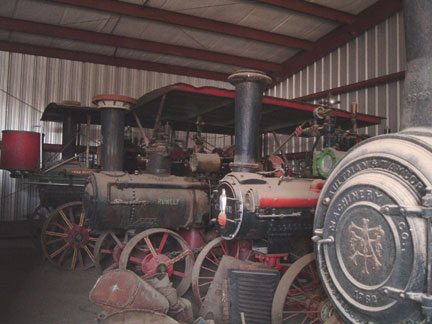
Minneapolis, Rumley, Case and Aultman-Taylor Steamers!
But this is about Peter Saispair. This would be a good time to mention a new way of pursuing history; the phenomenon of internet searches. To "Google" something has become a figure of speech. There are other competitors to the Google site, at the moment Microsoft's "Bing" is heavily promoted and we tried it out. Entering Peter Saispair's name generated a list of links that of course included the work of Petras, but some other striking items as well. One of them was his obituary, two in fact, as originally printed in newspapers of the time. They opened our eyes to the fact that Saispair's accidental death by drowning had prompted an investigation of foul play! What was this all about?
To ease our way into the Saispair story, we are on fairly safe factual ground in the account of his spending time in Scotland where he learned English. That would give him the distinction common to the most effective immigrant leaders, that is, being able to translate for the majority who could not. Two other such common characteristics were an interest in seafaring and attraction to the revival movement in Sweden. Like Captain J. Edgren who began their seminary in this country, Captain R. Jeanson who figured in their Iowa immigrant story, and others, Saispair aligned himself with the Swedish Baptist movement.
Being bilingual and possessed of inherent boldness, these men guided and advised the first generation of immigrants to find land, establish communities, schools and churches, and generally helped them to survive their arduous beginnings. His countrymen did not give him the title of "captain,", but indeed "konung"--- "king Sas-Per"! An independant account has him on an urgent trip to Fremont, and obstructed by high waters from crossing at the Logan mill. The proprietors improvised a raft consisting of a livestock trough and ferry him across. This vignette portrays a man who is "on the go" to conduct the business, often with government officials, that helped the immigrants with land dealings, attainment of citizenship, and a hundred other things.
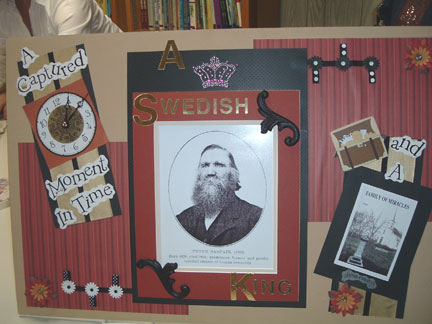
The display at the book signing
The first dwelling for himself and his family was a dugout. Soon he had a frame house, and when it burned, the first brick house in the region. He built a meeting house that may have served as a school as well as the place for worship. This was the structure now preserved by the Egbers. But evidently Saispair had his "lows" as well as his "highs." Today we think we have a better handle on this kind of human behavior. What we may be certain of is that it is nothing new.
On our first trip to the Oakland area, we found the Swedish Baptist cemetary but looked in vain for Saispair's grave there. The cover of Joann's book superimposes his gravestone on a picture of the Elim Lutheran church. Was Saispair buried in the Lutheran cemetary? Indeed he was.
C.F. Sandahl could write authoritatively about the Lutheran Conference history in that region, for he had pastored the Oakland church among his many tasks in Nebraska. He reports of their Elim congregation, that it had been variously known as Logan, Swaburg, Argo or Elim in the early days. He also reports that it was initially independant of any denominational ties. He undoubtedly knew much more, but the story may have been too long and involved to tell.
The Egbers filled in for us the sequences and developments which bring the story together. Logan mill, on the Logan creek, dated from 1863 or 64. There was both a sawmill and grist mill for grain. Immigrants from the east side of the creek (Swedish and Danish) and from the west (German) would have come to the mill with their grain. They may have patronized the sawmill as well though most accounts have lumber coming from the Missouri valley well east of there. The village of Logan had a post office, and later post offices were established at Sveaberg (Swaburg) and Argo to the northeast.
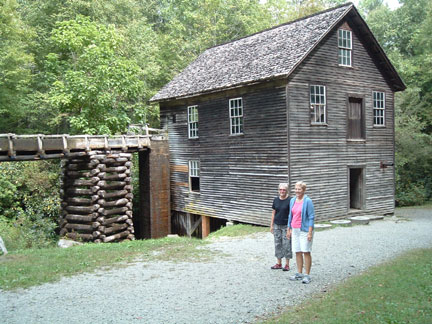
This turbine mill, an example like Logan's, stands in the Smokey Mountains
Swaburg is at the center of the story now, for there stand the living evidences of the Saispair era: Elim Lutheran Church and Swaburg cemetary, his final resting place. The story from the past...and how much is legend, let the reader decide...is that the Saispair schoolhouse / church was physically moved from the site near or on his homestead to a point across the road from the present Swaburg cemetary. It was done on icy, frozen roads...and when the Baptists came to church the next Sunday, it was gone! What had happened?
Logan was a community that was not indigenously Scandinavian while Swaburg was. The first Lutheran congregation at Swaburg included both Danes and Swedes. Was this seen as the center of the new community by Saispair? Was this why the church was moved? Joann has some other reasons to offer.
The Swedish revival movement had many facets: growing literacy (the revivalists were known as "readers"), chafing under state church authority, and a campaign against the unfortunate tendency for the oppressed to abuse alcohol. "Brannvin" was legally distilled in the homes and had become almost a staple item by all accounts. In this country, the Swedish churches in Nebraska aligned with prohibition as consistent with the temperance movement at home. That would certainly be true of the Baptists. The home in which Saispair grew up had its brannvin, no doubt. In the book, he is portrayed as one who practiced moderation, but not abstinence. But that might not have passed muster with his fellow Baptists. It could be another reason the church "moved."
Supplanting these speculations is the simple census record of his name: Sas Per Person. Sas with an unmarked "a" is not in the Swedish dictionary. Neither is Sas with two dots above the "a" (säs). But Sas with an "o" umlaut is (sås): it means "juice, or sauce." Those familiar with the immigrant generation will not be surprised at such plainspoken bluntness. Furthermore, Egbers had reached up to a high shelf in the old church building to bring down an artifact which he displayed with no comment: a brannvin still.
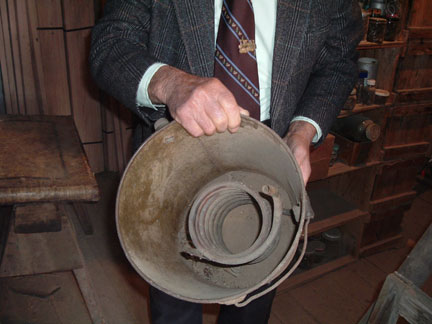
Could it be? Surely not!
There are some loose ends to tie for those who have followed this far: What about the St. Johns Danish Lutherans?
Just a couple of miles east of Elim church, on the same road, is the cemetary and site of this Danish church. The signboard in this cemetary reveals that it was at this church in 1884 that the Danish wing of the Norwegian-Danish synod declared its own independant status as an organization. Their new organization was popularly known as the "Blair church." It chose the term "association" of churches rather than a more formal title. The salvation of the individual ranked in importance above doctrine. It embraced the Scriptures as the Word of God and the first rule for doctrine and conduct. Only secondly did it also subscribe to the confessions of Lutheranism. Its desire to be associated with the "inner mission" movement in Denmark was specific and focused. Their historian observes that the Danish immigrants were slow to realize their options in the American context of freedom of religion. The existing Danish Lutheran church in America was inclined in its journalistic voices to accuse these mission people of being "Methodistic." It all sounds very familiar to us Swedes.
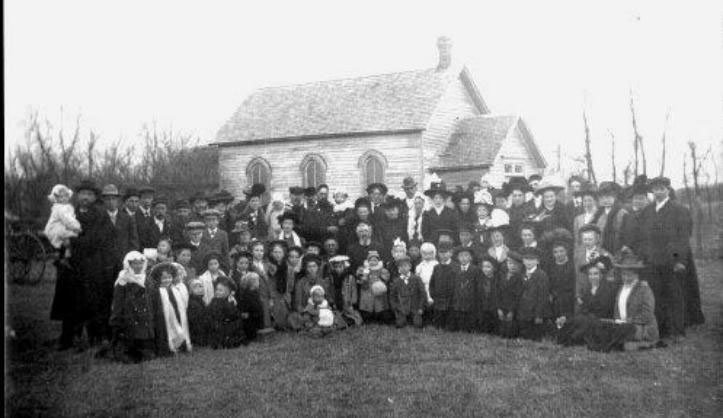
The people of St. John's Lutheran church, Danish
In fact there are some things the Swedes may learn about their own history from reading about the Danes. Nowhere in the Swedish chronicles, for example, do we learn that Elim pastor J. Torell was listed as pastor for St. Johns Danish down the road. Did his Augustana brethren take a "don't ask, don't tell" attitude? And when St. Johns was formed, a number of their charter members transferred from the Scandinavian Logan Lutheran congregation which preceded Elim. Another source was the St. Johns in Washington County to the south, which was of the Grundtvigian wing of the Danes; those whom the "inner mission" people opposed.
The Nebraska "inner mission" Danes had a history of congregating in common purpose before the 1884 events at St. Johns. Previously they had met in the quarters of the Swedish Immanuel Lutheran Church, Augustana, in Omaha. The Augustana Synod itself was a pan-Scandinavian venture till 1870. The very proximity of St. Johns, Argo, to Elim, Swaburg, is a startling reminder of the commonality Scandinavians experienced. Their idyllic and wistful site on Swaburg road is an unforgettable one.
Uehling, Nebraska
At first, we had no idea where to find Argo, Nebraska. We were not even aware of the existence of Swaburg or Logan. The answer is that they lie near Uehling, a small village between Fremont and Oakland on highway 77. We have not mentioned these things before, because for the stories of Argo, Swaburg and Logan they do not matter. They were not there and they came later...with the railroad. As in countless small communities, when the railroad came the population shifted to the stations and the old villages withered away. For the historian the normal pattern of things is reversed: highway 77 and Uehling are in faded black and white: Argo and Swaburg are in bright color.
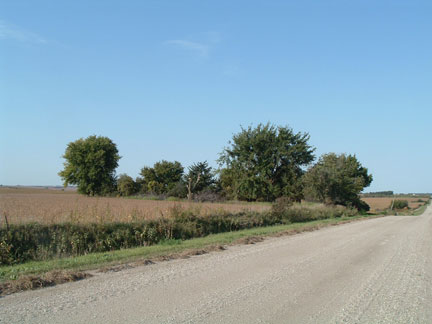
The site of the Danish church and cemetary
Just down the road from Elim / Swaburg
Like gold at the rainbow's end for churchfinders
Some more items on Argo
The Argo Mission church was not adjacent to the cemetary as we had imagined. (that cemetary lies just northeast of Elim / Swaburg) The Egbers informed us that it was located at the crossroads south of the cemetary. The Argo post office was some distance from the church on the east-west road, and a blacksmith shop at some further distance. There was an Argo store whose Jewish proprietor had assumed a Scandinavian name. (St. Johns Danish church also claimed the Argo address.) South of St. Johns, not far, is another cemetary and church site called Admah. It's members were in large part Danish, but Presbyterian. Another story. Swedish Lutheran mission friends, like their Danish counterparts, were reluctant to separate from their Lutheran roots and only slowly assumed the role of independant denominations. We may assume the Argo mission group was no different, and may have considered themselves to "belong" to Elim, at least in the beginning. The Egbers recalled the sale and dismantling of the Argo Mission church.
What about those Saispair obituaries?
How many times did someone leave a tavern in Hooper at closing time and end up in the Elkhorn River? A rhetorical question to be sure, but we would like to think the tragic end of Peter Saispair was an exception to the sordid rule. Were the circumstances alone enough for an investigation of foul play to be warranted? Was it merely routine? No doubt this question has haunted the Saispair family. Seen through the eyes of those descendants who suffered their own disfunctions, some paranoia could be understood. But were the demons that plagued Saispair primarily external or internal? Reading Joann's book will focus the question.
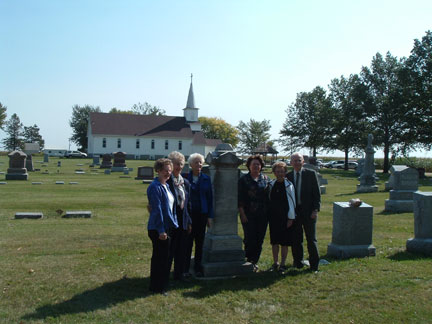
The final resting place of Peter Saispair
Joann begins her book with the scene of Peter Saispair's burial at Swaburg cemetary. A great cloud of dust rises from the host of wagons bringing mourners to his grave. We stood at that very place on the Sunday of our visit with his descendants, marveling. Few events drew such a crowd of people as the passing of that convivial pioneer. They remembered the tenuous early days. They remembered a strong leader and advocate, both physically and spiritually. And perhaps they also remembered the Scripture, "we have this treasure in earthen vessels."